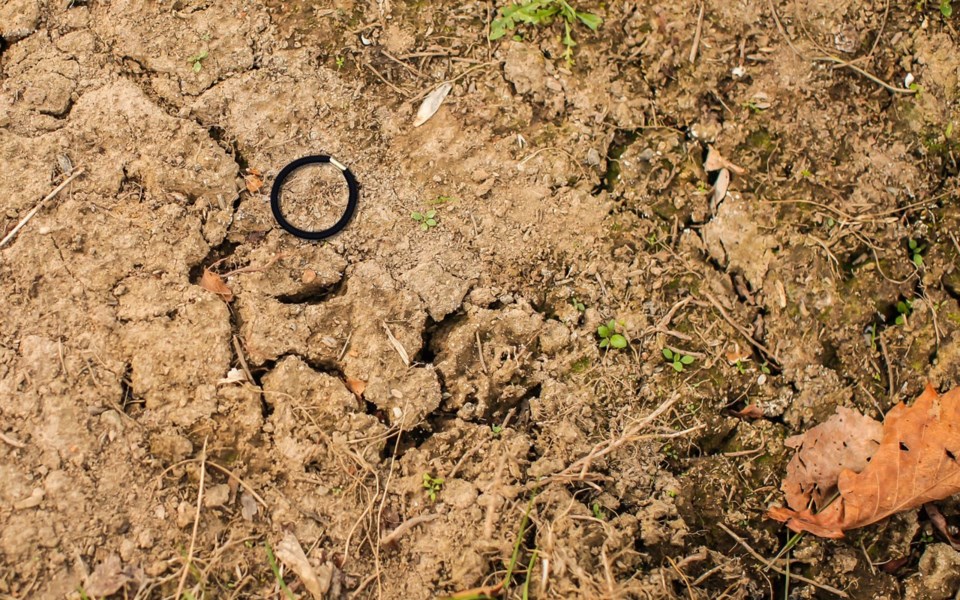In an obsessive drive to rid Creekside of the scourge of invasive burdock (I'll write about this in another column), I've spent much time mucking along the sides of the Valley Trail, the verge of ditches, the margins of peoples' yards, and the edges of gardens, sidewalks, parking lots, and roadways in general. As I cut and hack and shovel up the offending greenery, much is revealed about the habits of humans who frequent such areas. As you can imagine, it isn't pretty.
To start, it's truly impressive the efforts people will make to hide garbage they know should be placed in a trash or recycling bin—fast-food collateral, beer and cooler cans galore, and, of course, that badge of true laziness and general uncaring, the dog-shit bag. The irony of someone burrowing deep into the undergrowth to stash this stuff is that it would take equal or less effort to dispose of it properly. But I'm not here to talk about the general unconsciousness of humanity (again, another column). Instead, what I want to discuss—because it's both startling and intriguing—is the most common item encountered in my burgeoning new career as a burdock-basher. It's heartening, at least, to note this isn't the expected gum wads or cigarette butts. But it's a little strange to state that the object most commonly lost, misplaced, dropped, discarded, spontaneously generated, pooped out by birds, or rained down upon the Earth from the cosmos is this: the hair tie.
Indeed, these ubiquitous circular elastics are everywhere, accumulating in the corners of our lives, ground under heel into gravel or asphalt, infiltrating the pedosphere wherever you care to look—and, most importantly, places you don't care to look. It's like two invisible armies had a hair-tie war all around us. The war is over, but the spent ammo remains.
While it's hard to understand such profligacy, a few obvious clues suggest how hair ties escape control: they are small, imminently disposable, come in mostly neutral colours, and constantly break—despite being made of synthetics that will never disappear. This makes them a de facto pollutant. And if you want to add a social element, almost none are fair-trade. And yet, neither size, low-quality, camouflage nor disposability can account for their sheer number. There is, however, this fascinating phenomenon: if you watch someone wearing a hair tie, you'll note the regularity with which it is taken on and off, on and off, on ... and off, as if flaunting the odds the universe has set for losing one.
My own home is no exception. When my partner enters our dwelling, the first thing she does—before misplacing keys, phone or sunglasses—is march into the kitchen and deposit a hair tie on the counter. I find one every day, placing it in one of several baskets set around the house for their collection. These baskets, however, are forever empty, the contents evaporated into the ether. When I find hair ties in the car, I place them on the stickshift, where I think they will be handy. These also evaporate. This explains why hair ties precipitate out of the atmosphere.
And yet... hair ties must constantly—and inexplicably—be purchased. No less a sarcasm-slinger than thebeaverton.com published this noteworthy article: "Quantum scientists discover that the more hair elastics you buy, the fewer you have access to."
I recently saw an 18-pack (which left me wondering over other consumer products with 18 as a standard count) on which was printed "choking hazard." On any other product this would cause concern over their disposition, yet hair ties magically elude such scrutiny. Perhaps because keeping them in an obvious place—like your wrist—can also be dangerous: "A hair tie may cause a cut or an abrasion after chronically rubbing on your wrist," says a health blog (for real). "If the cut is deep enough, it can allow bacteria that normally live on the skin, or potentially dangerous pathogens such as MRSA or E. coli, to penetrate to deeper layers where they do not belong."
The extensive literature (not joking) on the subject universally urges a shocking first line of defense against this scourge: don't lose them in the first place. But since we now know that might not possible, perhaps we just need better-behaving, more sustainable hair ties. If you're wondering about zero-waste hair ties and alternatives, you'll be heartened to know these exist (start here: https://bit.ly/2ZlhpK4).
This column may be mostly tongue in cheek, but like all comedy, a laugh at our own expense is often illuminating.
Leslie Anthony is a science/environment writer and author who holds a doctorate in connecting the dots.




